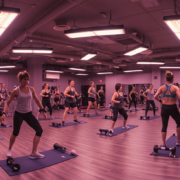In the 1920s, sportswear in America referred to the attire women wore to watch men play sports. A century later, this meaning has progressed significantly. Sportswear today means something entirely different through the influence of various sports, global icons and fashion trends.
Table of Contents
How is sportswear currently defined?
Also known as activewear, it is defined as clothing and footwear that is specifically worn for physical exercise due to its comfort, the support provided, flexibility, mobility and functionality.
Sportswear mainly consists of shorts, polos, tracksuits, running shoes etc., while women’s activewear includes sports bras, leggings, seamless clothing etc., mainly seen for non-competitive physical activities such as home workouts, gymming, jogging, etc.
In competitive sports, women’s activewear looks a little more diverse. For example, gymnasts and synchronised swimmers may often wear leotards/ swimsuits. Handball and volleyball players wear bikinis, while figure skaters and dancers wear short dresses with a lot of movement. However, this focus on comfort, elegance, functionality and aesthetics didn’t always exist.
When and where did athletic wear become common for women?
In the 1860s, women began to forge their way in the sport of Tennis. Their usual attire was long, white skirts and full-sleeved shirts, made of either flannel or serge. These were, quite obviously, obstructive and didn’t provide the ideal level of comfort or mobility required for this exerting sport.
French Tennis star Suzanne Lenglen revolutionised sports attire for women by opting to wear sleeveless tops with slightly shorter skirts along with a bandana.
From here on, there was a slow but sure progressiveness that took hold of women’s sportswear. By the 1980s, the now “80’s themed” attire consisted of figure-hugging, brightly coloured, comfortable leotards, bodysuits, feet warmers, etc. Seen not just for casual/ home workouts or yoga but also in the competitive sports scene, sports attire came a long way from the early 1900s.
What other influences changed athletic wear for women?
Bruce Lee is notable not just as one of the greatest martial arts specialists but is also known for popularising the tracksuit. Tracksuits have the added charm of being unisex, making them appealing to a wider population. They can be made with a variety of materials, cotton, velour, etc., that sometimes even cancel out their athletic properties, but tracksuits added a lot more options to women’s activewear. Not just for physical activity, but tracksuits can be considered as one of the early pioneers of athleisure, which has now become so common.
The use of nylon to make sportswear was also a turning point in the history of athletic attires, as nylon was not only durable but also comfortable, diverse in its uses for a wide variety of clothing options, and available in any colour. The use of nylon in sportswear production saw a massive change in women’s sports clothing as well. With the many options nylon provided, Olympic outfits, for example, became a lot more glamorous, personalised and most importantly, athlete comfort, mobility and usability became a priority.
The journey from the more restrictive and modest clothing, aimed at preserving a women’s ‘femininity’ on the pitch/ field, to more practical and personalised athletic wear has been a long one. But it hasn’t completely reached its end goal. In 2018, iconic tennis star Serena Williams was involved in a little controversy regarding her clothing at a Wimbledon match. Even though what she wore was custom made to suit her practical needs to a person well on the court, many were appalled that she chose to wear a catsuit rather than the usual skirt with shorts combo. The fierce backlash highlighted just how much is still yet to change, despite how far we’ve come in the past century.


















Comments